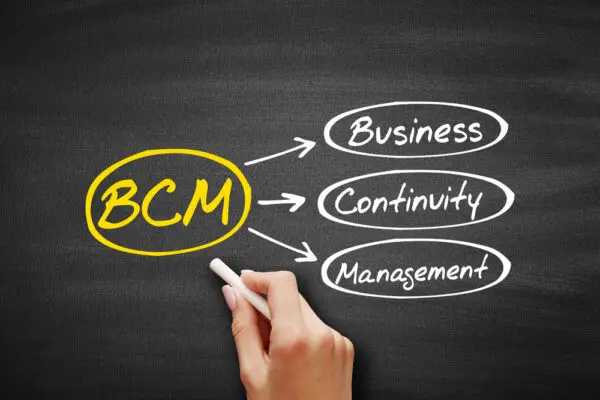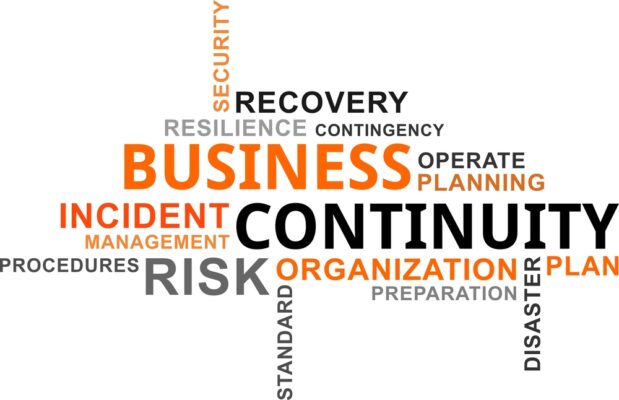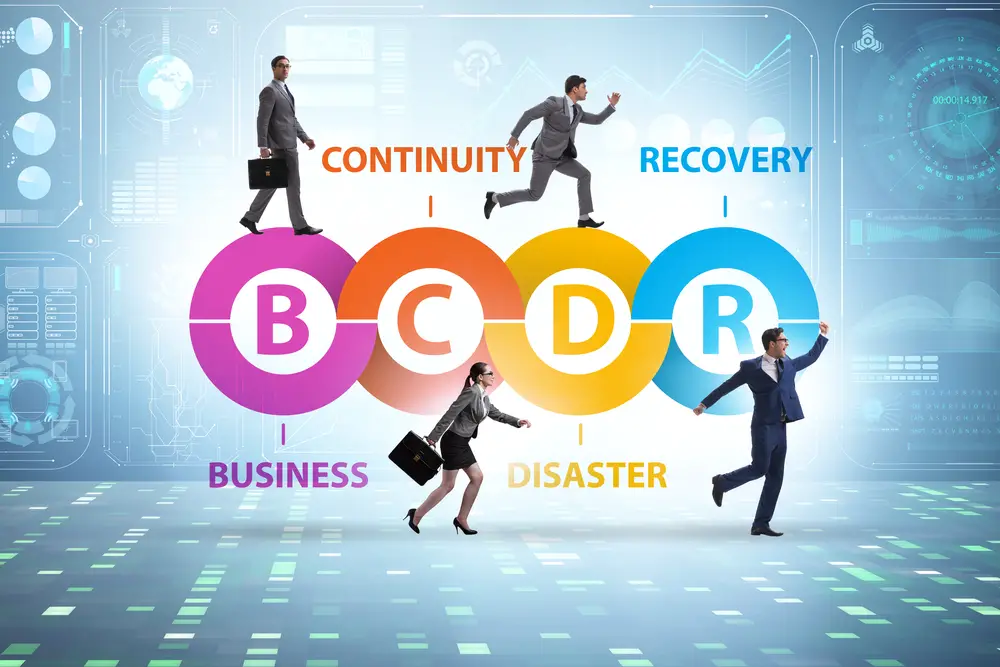A Business Continuity Management System (BCMS) Policy is a set of guidelines and structures that provide an organization with the direction, procedures, and measures to ensure business continuity during business disruption events.
It outlines clear roles, responsibilities, and processes for managing, mitigating, and recovering from such events. An enterprise risk management component.
The BCMS policy establishes a framework for handling disruptive events by outlining the procedures and processes for identifying risks, assessing their impact, developing contingencies, and implementing a response plan.
It should also include guidelines on testing, auditing, and maintaining the BCMS to ensure its ongoing effectiveness.
The policy serves as a blueprint for a business continuity management framework that every employee in an organization can use to prepare themselves and their respective departments for any potential disruptive events for business continuity planning.
The BCMS policy should be regularly reviewed and updated to ensure it is aligned with the organization’s objectives and that its guidelines are up-to-date in light of changes in technology or operational practices.
It should also contain protocols for managing communications around disruptive events, as well as for documents.
The BCMS includes risk assessments, business impact analyses, recovery strategies, and testing plans to ensure that an organization can respond quickly and effectively during any disruption. Details the business continuity strategy for the organisation.
The goal of a BCMS policy is to minimize the effect of any disruption on an organization’s operations by keeping essential services available and operational. This includes planning for how the organization will continue its operations if it faces natural disasters, cyber-attacks, or other unforeseen events.
To create an effective BCMS policy, organizations should outline all aspects of their continuity plan, including how risks will be identified and managed, what resources are needed for recovery, how data will be backed up and stored securely, as well as detailed instructions for employees on how best to prepare for potential disruptions.
A Business Continuity Management System (BCMS) policy is essential to any business. It outlines the procedures, processes, and strategies businesses can use to ensure operational continuity during a disaster.
A comprehensive Business Continuity Management System Policy is essential for reducing risk and protecting against unforeseen events. But what exactly does such a policy entail? This article will provide an overview of what’s included in a BCMS (Business Continuity Management System) Policy
How it works, and why it’s important. Tips to creating one – so you can ensure your company is prepared for any scenario that could potentially threaten its operations. Read on to find out more.

What Does a BCMS Policy Do?
A BCMS policy provides guidelines for developing continuity plans that will minimize disruption and enable operations to continue during times of crisis.
The policy should include an assessment of potential risks and vulnerabilities and strategies for responding to them. Additionally, it should contain backup plans if primary systems fail or become unavailable.
The Benefits of Having a BCMS Policy
A BCMS policy is essential for ensuring business continuity in times of crisis. Businesses can minimize disruptions and quickly recover from disasters by having a plan in place.
Additionally, a BCMS policy ensures that all employees are aware of their roles during an emergency and understand what steps need to be taken to prevent further damage or disruption.
Finally, having a BCMS policy shows stakeholders that your business takes its responsibilities seriously regarding managing risk and protecting data security—which can help build trust with customers and improve customer service experiences.
Outline of Business continuity management policy
Business continuity management systems (BCMS) are essential for organizations to ensure the continuation of critical operations during a disruption.
A BCMS is a comprehensive set of policies, procedures, and processes that help organizations identify potential risks, develop strategies to mitigate them and create plans to respond quickly and effectively in the event of an emergency.
The policy outlines the procedures and guidelines for implementing, maintaining, and evaluating a Business Continuity Management System (BCMS) to ensure that business operations are adequately planned and prepared for potential disruption.
The objectives of a BCMS are to:
-Identify critical processes, products/services, resources, and infrastructure that an event or emergency may impact;
-Establish plans to protect against risks associated with such disruptions;
-Implement preventive measures and controls to minimize damage should an incident occur;
-Ensure business continuity during and after the incident;
- Test systems regularly to ensure their readiness in the event of an emergency;
- Monitor progress in achieving BCM goals and objectives; and
- Make necessary adjustments as needed in response to changes or new trends in risk management.
All personnel must adhere to this policy when engaging in any activity related to implementing or maintaining a BCMS, including planning, training, exercising, testing, and reviewing plans/procedures.
All staff members must understand their roles and responsibilities when it comes to participating in the development and operation of a BCMS so that they can effectively address any disruptions or contingencies which arise.
The policy outlines the requirements for establishing and maintaining a BCMS within our organization. This policy will cover topics such as risk assessment, business impact analysis, disaster recovery planning, testing, and training.
Risk Assessment
Risk assessment is an important part of any BCMS. It involves identifying potential risks that could affect our operations and assessing their likelihood and impact on our organization.
The risk assessment results should be used to prioritize areas for improvement to reduce or eliminate identified risks.
Business Impact Analysis
A business impact analysis (BIA) determines which business functions are most critical for our organization’s continued operations.
The BIA should include information about each function’s importance, dependencies on other functions or systems, resources needed to maintain it, and recovery time objectives (RTOs).
Disaster Recovery Planning
Once we have identified our critical business functions through the BIA process, we can develop a disaster recovery plan (DRP).
The DRP should include detailed instructions on how each critical function will be recovered in the event of an emergency. It should also include information about backup systems or resources that can be used if necessary.
Testing & Training
Testing and training are essential components of any BCMS. Regular testing helps ensure that our plans are up-to-date and effective in responding to different types of emergencies.
The business continuity manager ensures that key personnel involved in the BCMS understand their roles and responsibilities during an emergency.
Purpose of policy
The policy will address critical incidents impacting the organization’s critical functions. The Continuity Management Plan and Business Continuity Governing Policy have been incorporated into the wider resilience plan.
Specifically, the organization created this document set of procedures to identify and address critical events resulting in the loss of assets and operations.
Policy Statement
To achieve the business objectives of enterprise operations and maintain continuity, the company adopts and implements well-developed and reliable plans and procedures to build resiliency among team members and infrastructure and manage the rapid and efficient transition to the business system.
BCM Policies reinforce the commitment of a company towards providing rapid and high-quality based services and providing backup arrangements, ensuring customers, company operations, and service are not compromised or damaged. Continuity procedures are outlined in Backup Policies.
Policy scope and application
The policy applies to the entire staff, customers, board members, and other stakeholders. This applies to all organization’s locations owned/owned by the organization.
Corporate BCM Practice Statement
The document also has a summary of its objectives and its scope.
Key outcomes and outputs
The key result of the policy includes: developing and implementing a business continuity plan and developing procedures and tools for preventing and dealing with incidents.
Distribution and Maintenance
The BCM document is accessible to all employees covered by that agreement. Whenever a person is affected by a particular document, the updated version is accessible to that person. Maintenance of the BCP documentation falls on the CIO and BCM teams.
Policy owner
Usually, the policy owner must have been the top-level person in the risk management area. In addition, those who are responsible for corporate risk management should own their own BCA policies.
Objectives of Business Continuity Policy
A Business Continuity Management System (BCMS) policy is designed to help organizations sustain their operations during a disruption or disaster. The policy outlines the objectives and steps needed to ensure an organization can respond quickly and effectively.
The primary objective of a BCMS policy is to minimize the effect of any disruption on an organization’s operations by keeping essential services available and operational.
This includes processes and procedures for how the organization will continue its operations if it faces natural disasters, cyber-attacks, or other unforeseen events.
The BCMS should also include risk assessments, business impact analyses, recovery strategies, and testing plans so that an organization can be better prepared for potential disruptions.
Additionally, it should include details on how data will be backed up and stored securely and instructions for employees on how best to prepare for potential disruptions.
Protecting the assets of the firm. Business continuity management ensures you are ready in case of any disaster while ensuring those working on this plan understand their chances.
Keeping the Company in operation. The Company will have the ability to operate.
Corporate requirements
A BCMS policy outlines the corporate requirements of an organization’s business continuity and disaster recovery plans, processes, and procedures. It should include a process-oriented approach that involves interaction between management processes, business processes, and support processes.
The BCM policy should demonstrate leadership and commitment concerning the BCMS by ensuring that the business understands its objectives and requirements.
It should also guide how to develop, implement, operate, monitor, review, maintain, and improve the BCMS.
Additionally, it should set out the BCMS program’s scope and any regulatory technical standards that specify the organisation’s requirements.
An internal audit of procedures and policies is necessary to ensure compliance with ISO 22301:2019(en), Security and Resilience standards.

Bcm Program Maintenance Guidelines
Organizations should also establish maintenance procedures and schedules, create processes for identifying risks and threats, nominate the right person/business units to maintain and manage the BC Plan and set up criteria for measuring performance against objectives.
BCM provides support to business continuity plan ownership and policy statements.
Scope of supporting policy guidelines
Creating policies that help businesses improve their continuity of operations is important. This framework enables a comprehensive risk management plan across various levels of the organization.
Conclusion
All businesses should have an effective Business Continuity Management System (BCMS) policy in place—it’s simply good practice!
A comprehensive BCMS policy not only helps protect against threats but also helps organizations respond quickly and efficiently if those threats become a reality.
The benefits of having a solid BCMS policy include minimized disruption during emergencies, improved risk management practices, increased customer trust, better employee understanding of their roles during crises, and improved customer service experiences overall. So don’t delay—developing your own BCMS policy today could save you time and money.
Have you read?
What is a business continuity management system?
Business continuity management systems
Objectives of business continuity management system

Chris Ekai is a Risk Management expert with over 10 years of experience in the field. He has a Master’s(MSc) degree in Risk Management from University of Portsmouth and is a CPA and Finance professional. He currently works as a Content Manager at Risk Publishing, writing about Enterprise Risk Management, Business Continuity Management and Project Management.


